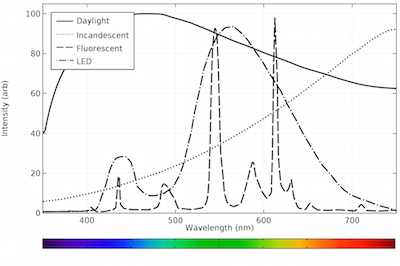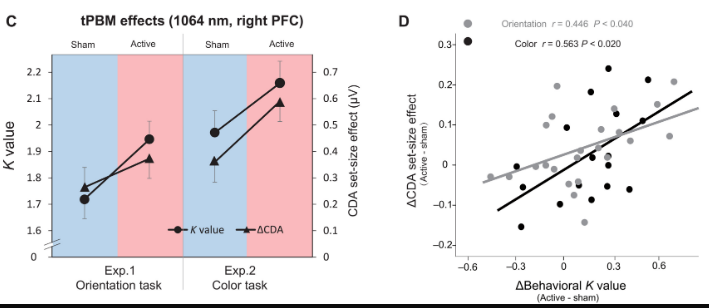Gut check before reading the article: this sounds like a way to prank credulous SWEs by convincing them to make little LED hats to shine on their foreheads.
Summary of shallow dive
A lot of the early evidence for cognitive benefits in healthy individuals come from a set of small, older studies by a single research group showing pretty small effects.
But then in 2022, much better evidence came out showing medium effect size benefits for visual working memory in 90 healthy subjects in Science Advances, by a different research team in double-blind sham-controlled trials.
But this was no LED on the forehead. It was a 12-minute exposure to a medical device laser at one-fifth the skin's maximum permissible exposure, with the laser light striking a 4 cm diameter patch of skin. Medical device lasers are quite expensive. It would probably be fairly easy to self-apply, which is a huge advantage. On the other hand, you can definitely hurt yourself with a laser, and the high cost/modest-and-uncertain benefits make this a questionable-seeming investment.
I'm very curious to know how the effects on cellular respiration (the purported mechanism of action) compare to daylong exposure to sunlight.
I think these researchers are "no evidencing" the risks. In the short run, I buy that this is a low-risk intervention. In the long run, increasing the rate of cellular respiration and producing ROS as a result seems like it could set you up for negative health effects. I'm not confident in that, but this is a very low-evidence realm for both benefits and potential harms.
RE: the hacker news quote, it's cheap to try rigging up an 850 nm LED to a watch battery and sticking it on your forehead under a beanie. Try making two identical LED beanies, one with an 850 nm LED and one with a 400 nm LED (placebo), and do a self-blinded sham-controlled trial.
But I wouldn't take this commenter's word for it - the size of the claimed effect is much bigger than literature reports, the intervention far less powerful and controlled, the evidence nil. Sounds like it's straight made up at worst, and a placebo effect at best. But I could be wrong!
Unedited record of an hour-long shallow dive
OK, let's have a sympathetic look. 127 citations, and the paper isn't just a one-off. It's called "Brain photobiomodulation," and involves using red to near-infrared light, primarily to treat neuro/psych conditions. There are a decent number of underlying citations.
The mechanistic thesis is that these wavelengths stimulate the mitochondrial electron transport chain, the most important producer of energy in the cell. Specifically, the terminal enzyme of the ETC, CCO, has heme and copper centers, which respectively absorb light best at 620, 655, 680, 760, and 825 nm. Light shining on this enzyme is absorbed by these metal centers, exciting their electrons, destroying inhibitory nitrous oxide in the center of the enzyme. Higher wavelengths, including 980 nm, 1064, 1068, and 1072 nm have shown benefits in other studies. There's a balance between the tendency of light to scatter through tissue vs. its ability to be absorbed by relevant enzymes at specific wavelengths.
A potential downside is that this would tend to increase reactive oxygen species, which are purported to be a driver of aging, standing in contrast to the claims of "no negative side effects" in this article.
Red and IR wavelengths of light pass efficiently through tissue. For example, red and IR LEDs are used in pulse oximeters to measure blood oxygenation, because O2-saturated blood absorbs these wavelengths differently from unsaturated blood, and we can detect the difference in light transmitted through the finger using photodetectors on the other side of the skin. If they can pass through and be partially absorbed by finger tissue, then they can potentially pass through and be partially or ~completely absorbed by brain tissue as well. I don't know to what extent the presence of the skull affects the amount of light you have to apply.
If true, this would help explain the perceievd beneficial effects of sunlight. Out in the sun, you get much higher doses of red and IR light (600-1100nm) than you do indoors.

From an evolutionary biology perspective, we've had billions of years of evolution in the context of sunlight, and it would make sense that evolution has found any way possible to achieve optimal reproduction in that context. An intervention that essentially involves making our indoor light environment more similar to our ancenstral environment makes fundamental sense to me.
So we have:
- A specific mechanistic hypothesis about how light affects tissue and how these effects translate into psychological benefits, one that is quite testable in vitro and on humans, based on well-established physics
- A very low risk profile prima facie
- A highly plausible evo-bio story (i.e. in the modern indoor environment, we are missing out on light sources that our brains were evolved to take advantage of to drive cellular respiration)
- A respectable-looking body of underlying literature
- An intervention that's truly easy to test (apply light to the forehead), unlike the recent article that involved matching photostimulation to the eye in sync with measured brainwaves.
- Reported benefits to prefrontal rule-based learning, sustained attention, short-term memory, executive function, and underlying physical performance of brain tissue (but note that cited studies for the benefits in healthy patients are all from one research group and are ten years old, though published just a year or two before this review article).
Let's look at the purported benefits and see if they seem astounding enough to gamble on further research and engineering.
This is what the laser they used looks like:

- Study 1 had a 20-person experimental and a 20-person control group of healthy volunteers.
- "Reaction time... was signfiicantly improved... especially in high novelty-seeking subjects."
- The control group underwent the same procedure as the treatment group, but received a brief (5-s) treatment to the intended site on the forehead, followed by 55 s of no treatment, for each one-minute cycle. Thus the control group received approximately 1/12th of the cumulative energy density as the treatment group.
- Subjects were blinded to condition.
Affect scores (before treatment and two weeks after treatment):

Thought I don't loooove p = 0.043, but then again it's just a 20-person study.
Psychomotor vigilance task (PVT):

This is a measure of reaction time, so lower = better. Again we have an irritating p = 0.047.

OK, it's not that convincing when we think about the fact that this is a small pilot study, not preregistered, observing small effects, with some outlier removal, and we don't know about publication bias in this literature.
Here's a followup even smaller study on executive function in undergraduates by the same group.

So yeah, a smallish-looking bump, but again those basically-.05 p values! p = .048, tons of nonsignficant additional interaction tests.
Here are figures from another of this group's studies:

Wait I found evidence by somebody else in Science Advances from last year!
Transcranial photobiomodulation enhances visual working memory capacity in humans
Four double-blind, sham-controlled tPBM experiments. Good figures and data presentation.

The mean tPBM effect (active minus sham) on the K values for experiment 1 was 0.186 ± 0.065 (BF10 = 5.212 and Cohen’s d = 0.568), and the mean tPBM effect on K values for experiment 2 was 0.188 ± 0.051 (BF10 = 20.336 and Cohen’s d = 0.651).
These would be traditionally classified as "medium" effects based on Cohen's d.

When you tried it out, did you go as far as to hook yourself up to a brain scanner and match the flashes to the frequency and phase of your (alpha?) waves? My memory of the paper was that getting the phase and frequency right made a big difference for the effect.
Importantly, that paper also studied the benefits of entrainment matched to phase and frequency of brainwaves for learning a very specific type of dynamic visual recognition task. My take on the paper was that it seemed unlikely to extrapolate to learning generally (i.e. it wasn't "strobe yourself and learn anything 3x faster").
By contrast, the body of research here finds modest effects, but on a wide range of cognitive performance tasks and with a clear mechanistic hypothesis to explain why this might be happening. I think employing powerful medical lasers, as in the original studies, is far more plausible and tractable as a general learning-enhancement strategy than the strobe light brainwave-matching. But the effects sizes are small enough and the risks uncertain enough that it doesn't seem worth the investment to me.